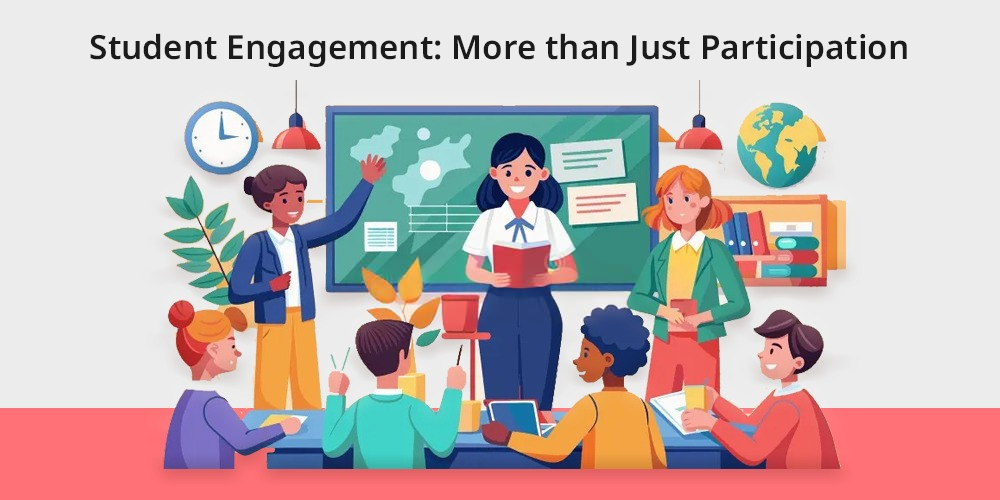
In this modern and evolving world of education student engagement is a center of attraction for everyone.
From teachers administrators, policy makers to students, student engagement is everyone’s need. But have you ever thought about what this concept means?
Is it simply about raising hands for asking questions from the teacher and completing work by taking homework tips or there is more?
In this modern education system student engagement includes a lot of elements to which students are involved and interested in.
To know more about Indian online education read advantages of Indian education system.
For example their learning experience, including their cognitive development, emotional, and behavioral participation.
Table of Contents
- What is Student Engagement?
- Why is Student Engagement Important?
- How to Improve Student Engagement?
- How to Engage Students in Class?
- Classroom Observation Checklist for Student Engagement
- Types of Student Engagement
- Benefits of Student Engagement
- Factors Affecting Student Engagement
- Challenges in Promoting Student Engagement
- Effective Strategies or Best Practices for Student Engagement
- How Online Education is Evolving to Meet New Engagement Needs?
- 10 Activities to Engage Students in Classroom
- Examples of Student Engagement
- Key Takeaways!
What is Student Engagement?

The term student engagement means the level of connection and investment a student does in their learning, educational environment and knowledge.
Also learn top 10 fun and engaging educational activities for kids.
Remember student engagement is more than just participation in the initial level or following instructions.
True student engagement process involves students’ deep thinking, feeling connected, and active involvement in learning. It should further include the other linked activities for enhanced fine motor skills development.
Why is Student Engagement Important?
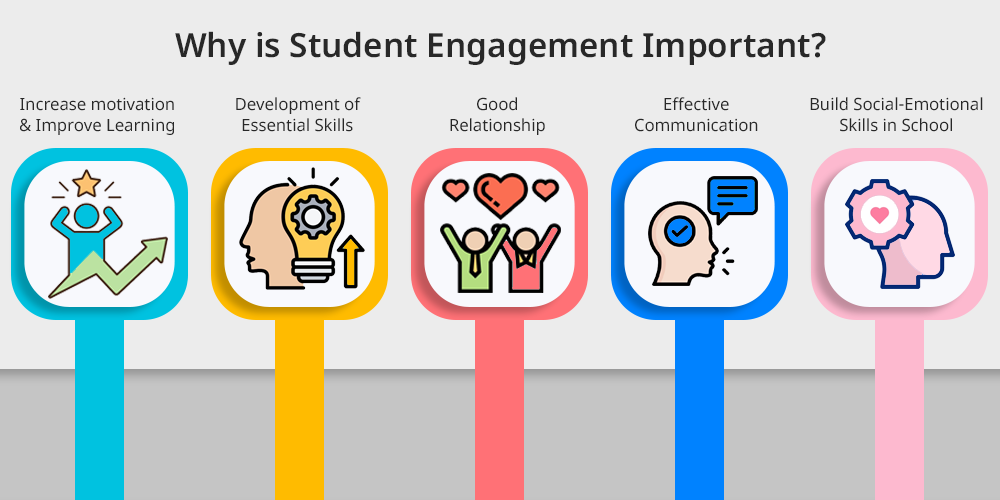
Before going for how to improve student engagement we need to understand why student engagement is important?
Student engagement not only includes the physical presence of a kid but also mentally invested to learn in a better way. In essence, they become active participants in their own education journey.
There are many questions in parents, teachers and even students’ minds. Why is it crucial?
For academic success student engagement improves learning outcomes, fosters a positive learning environment, and increases motivation and retention.
The significance of student engagement can’t be ignored. Engaged students are more likely to:
- Increase motivation & Improve Learning: Creating curiosity enhances motivation in learning new topics. Recognition, goal setting, and interactive lessons is the best way to do so.
- Development of Essential Skills: Developing confidence, leadership skills in students, building critical thinking skills and problem solving skills in students helps in personal and academic achievement.
- Good Relationship: Good relationships with educators and students build trust and respect. These interactions make the environment healthy. Group discussions, teamwork, and peer learning activities promote student connection.
- Effective Communication: Enhance communication skills in students. It improves academic performance and growth. Here you can also read how to improve communication skills for students.
- Build Social-Emotional Skills in School: Build social emotional skills in school. Understand why social-emotional learning is important for students.
As per research, high student engagement levels help students to perform better in academics and feel confident in community.
How to Improve Student Engagement?
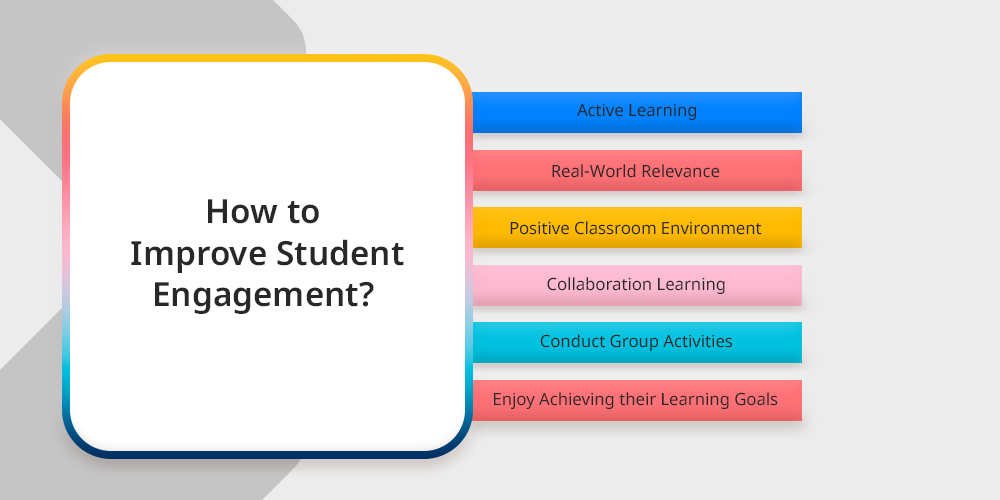
Many teachers and parents look for effective strategies to engage student in the classroom.
Some popular activities include active learning techniques, connecting content to real-world examples, differentiated learning, creating a positive and inclusive classroom environment.
Let’s understand the strategies to improve student engagement in detail:
1. Active Learning
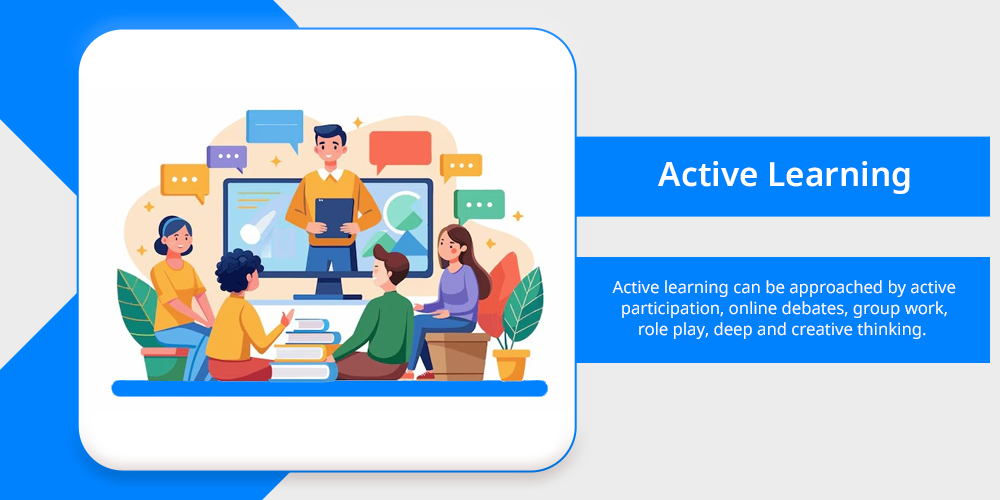
For improving student engagement, active learning is ideal. It incorporates interactive learning, collaboration, and connects chapters to real-world applications.
Active learning can be approached by active participation, online debates, group work, role play, deep and creative thinking.
2. Real-World Relevance
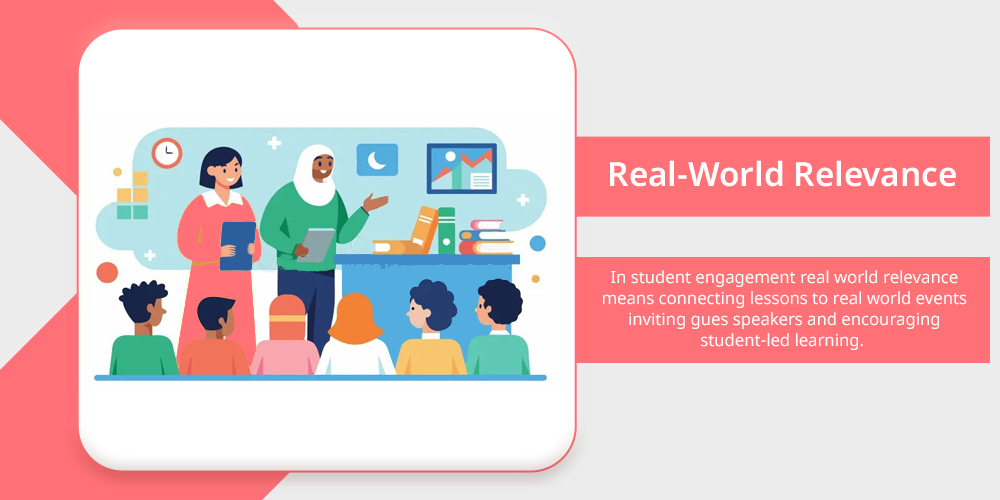
In student engagement real world relevance means connecting lessons to real world events inviting guest speakers and encouraging student-led learning.
This approach will foster a sense of ownership and make the learning methods more meaningful and relatable.
3. Positive Classroom Environment
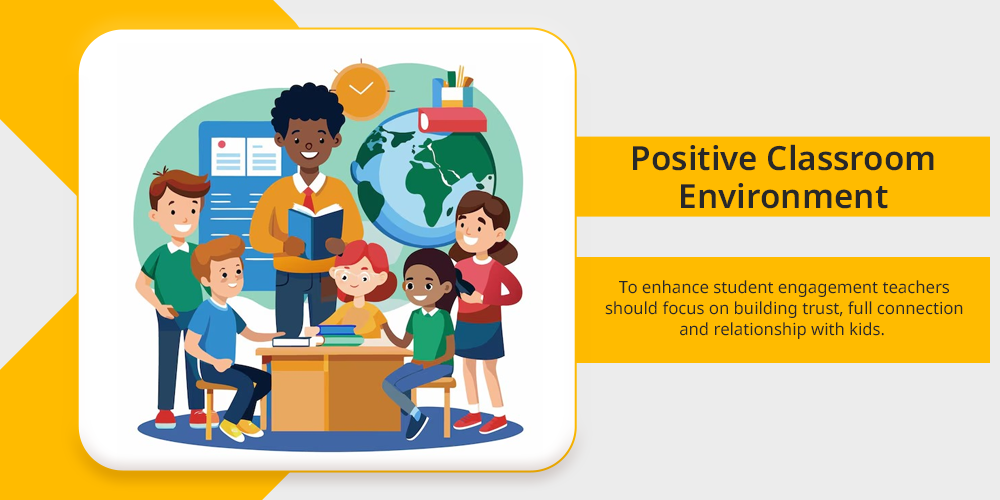
To enhance student engagement teachers should focus on building trust, full connection and relationship with kids.
This can be done by implementing positive reinforcement and creating an engaging learning environment for each child.
4. Collaboration Learning
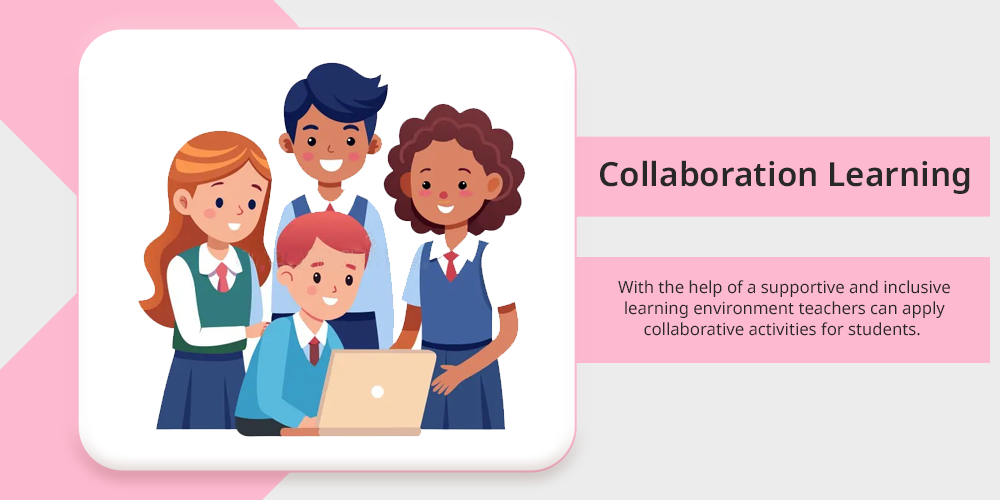
Collaboration learning is a lot limited to peer interactions. With the help of a supportive and inclusive learning environment teachers can apply collaborative activities for students.
Additionally you can take the support of online teaching, classroom learning and technology support for students’ success.
5. Conduct Group Activities
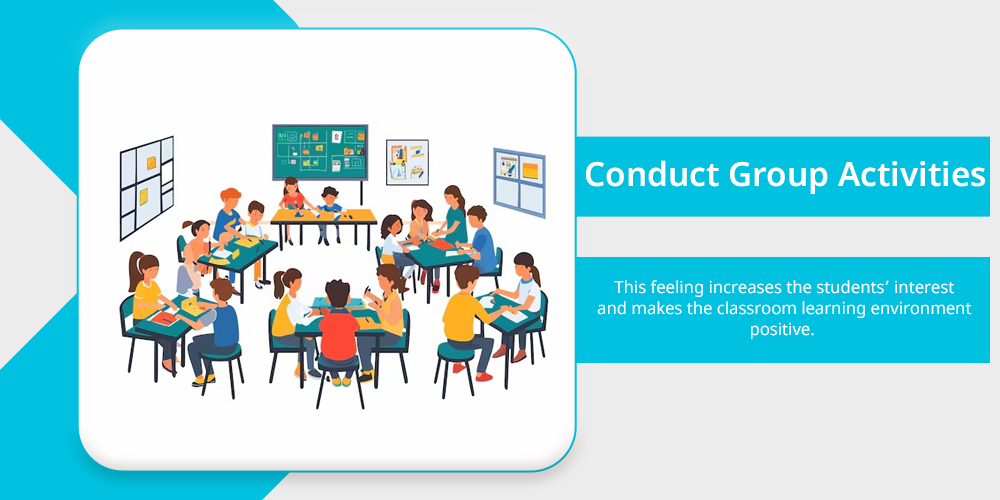
By conducting group activities teachers should promote students participation, facilitate group cohesion, and provide clear guidelines and expectations.
This feeling increases the students’ interest and makes the classroom learning environment positive.
6. Enjoy Achieving their Learning Goals
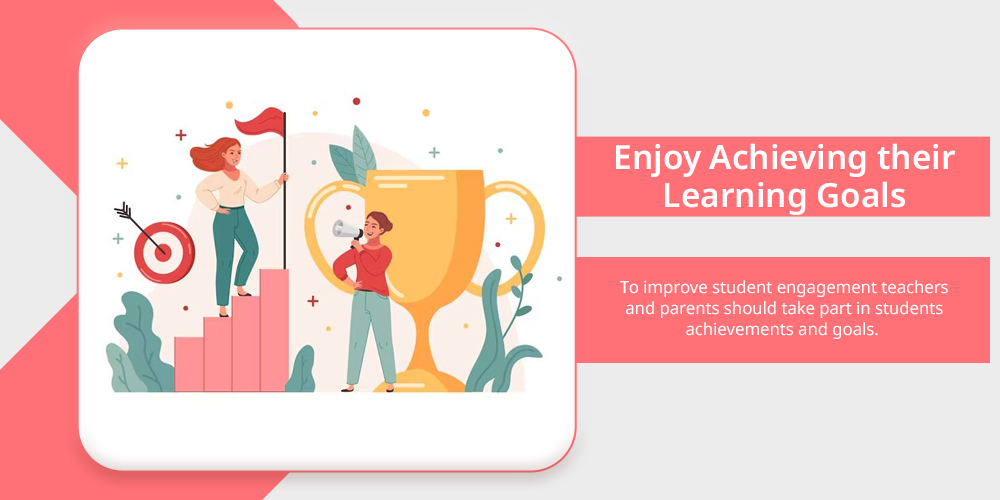
To improve student engagement teachers and parents should take part in students achievements and goals.
By setting clear learning goals, adding real-world connections, encouraging active learning and collaborative work can motivate students.
How to Engage Students in Class?
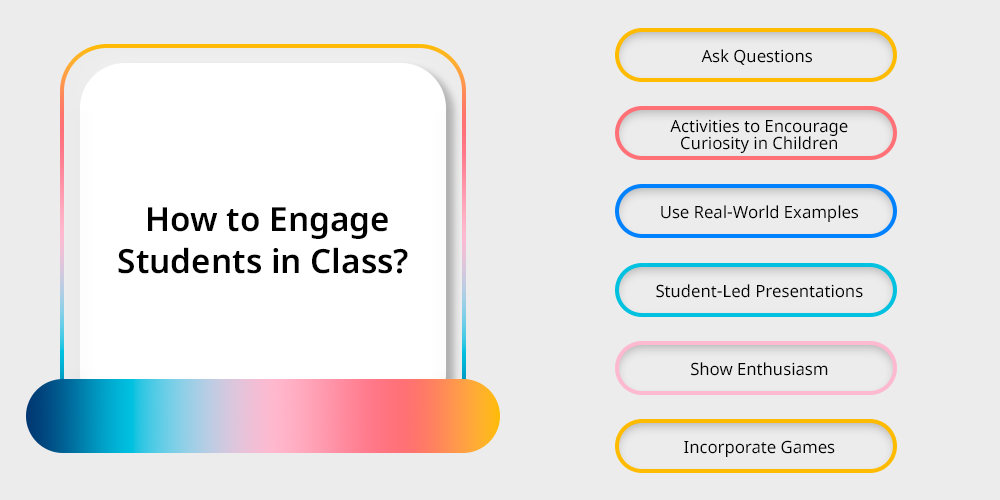
Encouraging students in real time by physically or in virtual classrooms requires in depth planning and implementation of each step.
Here are some proven methods of student engagement:
1. Ask Questions
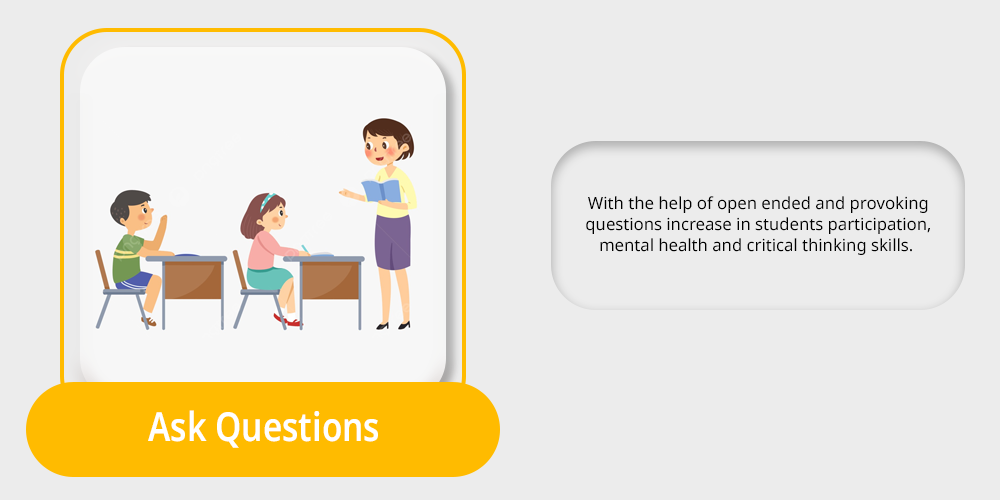
Teachers should start with a hook or asking questions from students related to the lesson going on to create curiosity.
With the help of open ended and provoking questions increase in students participation, mental health and critical thinking skills.
2. Activities to Encourage Curiosity in Children
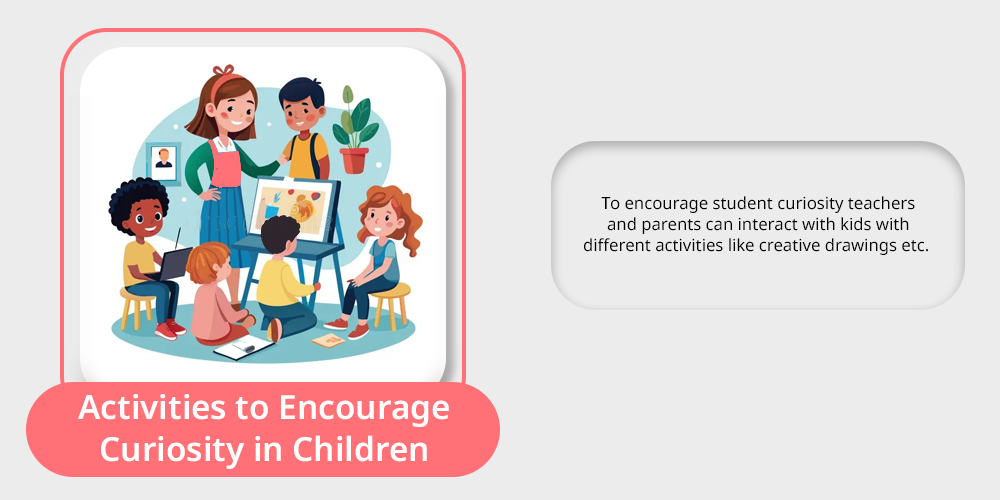
To encourage student curiosity teachers and parents can interact with kids with different activities like creative drawings etc.
Also Read: 10 creative drawing ideas for kids.
Remember this activity should be connected with student learning which helps as a building block of education.
3. Use Real-World Examples
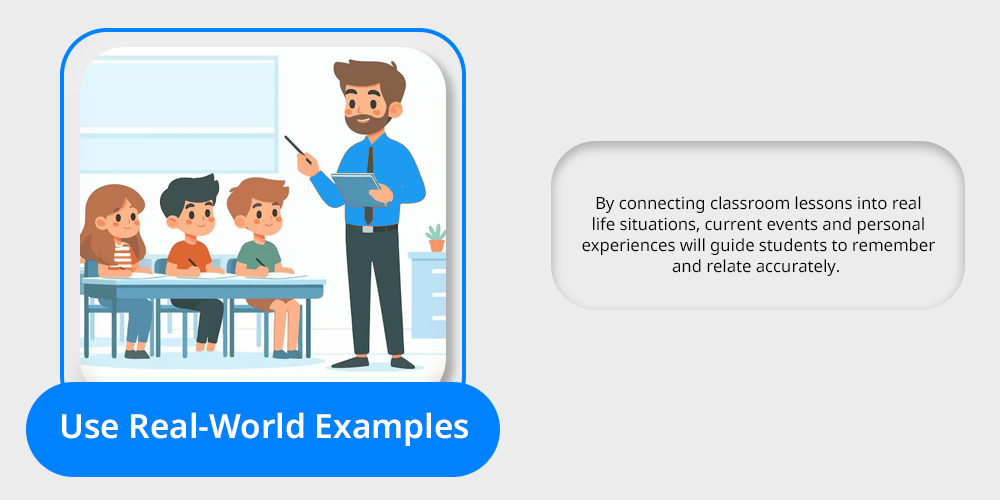
By connecting classroom lessons into real life situations, current events and personal experiences will guide students to remember and relate accurately.
This will not only help in understanding the scenario but also strengthen students memory.
4. Student-Led Presentations
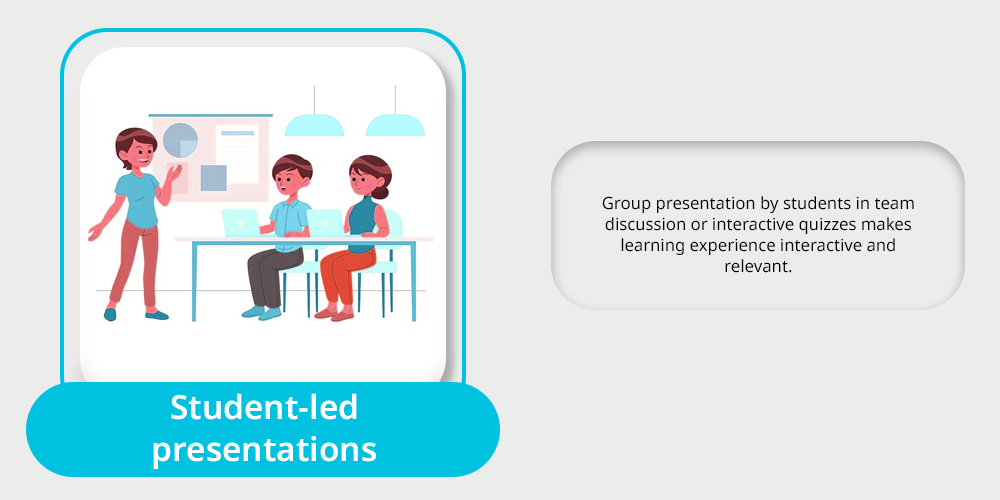
Student-led presentation means patient in group presentation in team discussion or interactive quizzes which focus on making the experience interactive and relevant.
By implementing student-led presentations one can create an engaging learning experience.
5. Show Enthusiasm
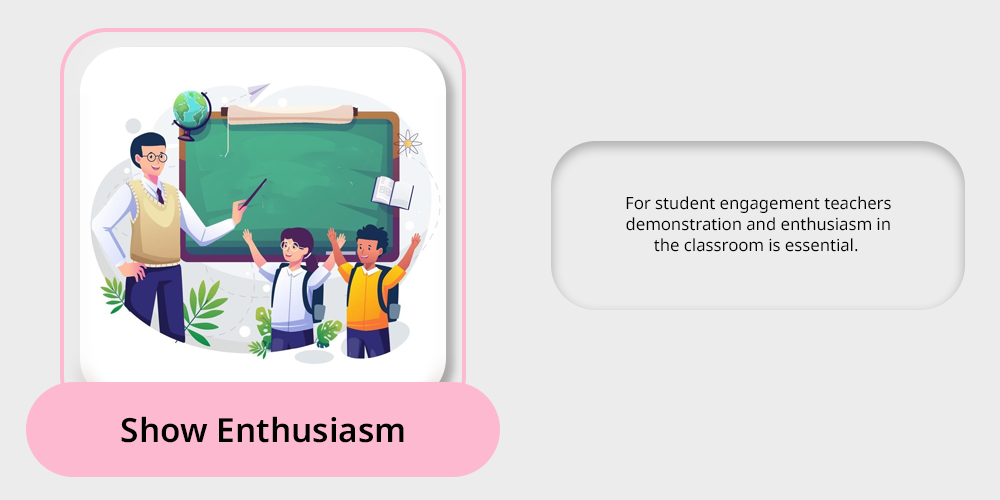
For student engagement teachers demonstration and enthusiasm in the classroom is essential. By incorporating unique and diverse teaching methods teachers can support students.
6. Incorporate Games
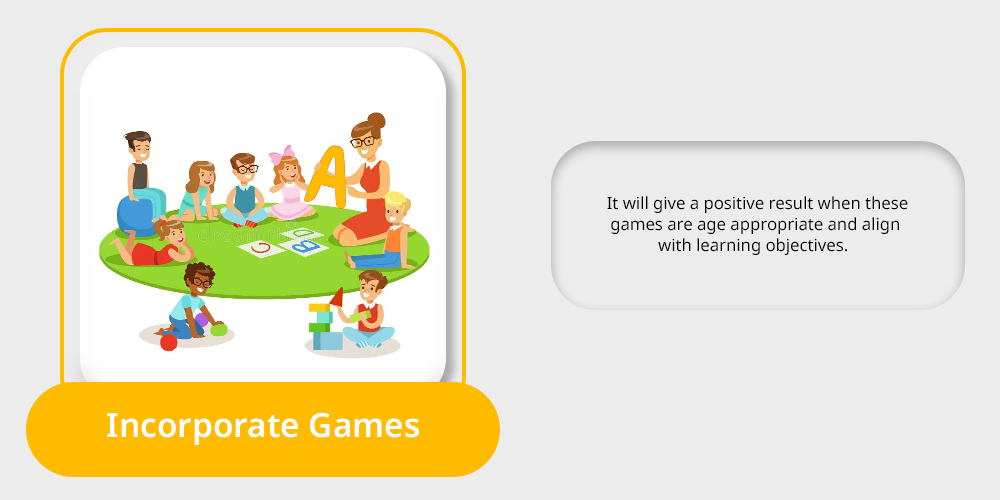
Incorporating games in class is a relevant way for student engagement. Teachers can discuss with students before choosing the games.
However, it will give a positive result when these games are age appropriate and align with learning objectives.
Classroom Observation Checklist for Student Engagement
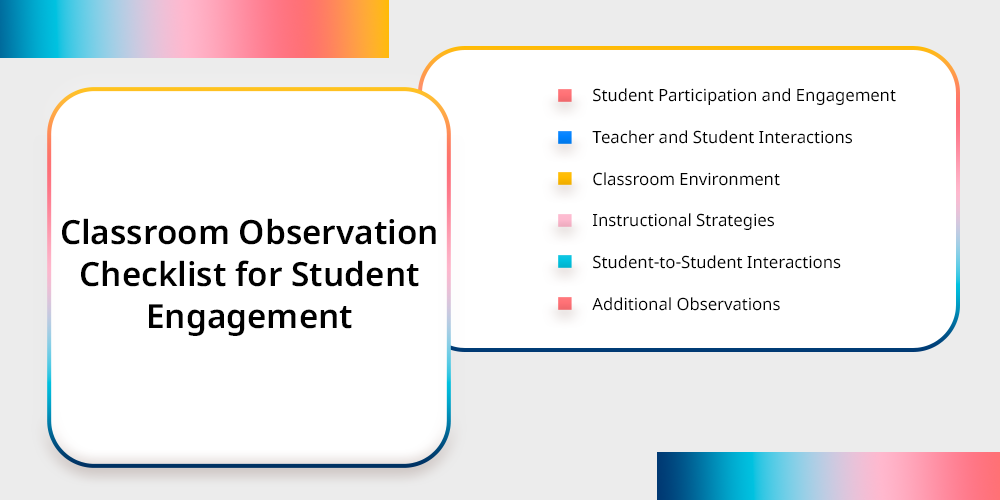
A classroom observation checklist is the best way of understanding how actively students are participating in class work, lessons, coordinating with teachers and classmates.
Classroom observation checklist has lots of things which educators need to observe. From student participation, interactions with the teacher and peers, to the overall classroom environment.
Lets understand in detail what classroom observation checklist includes:
1. Student Participation and Engagement
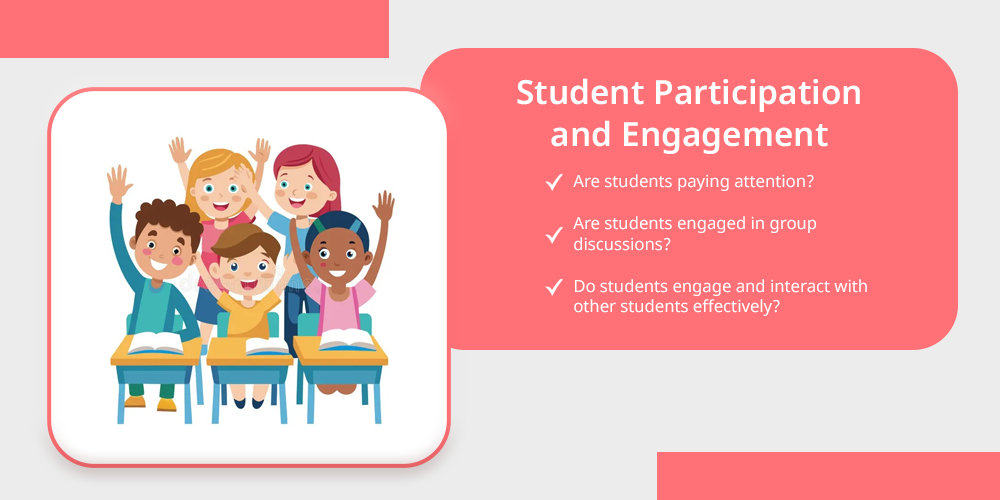
- Are students paying attention or active listening in the classroom?
- Are students asking questions about concepts?
- Are students engaged in group discussions?
- Do students follow instructions in time given by educators?
- Do students engage and interact with other students effectively?
2. Teacher and Student Interactions
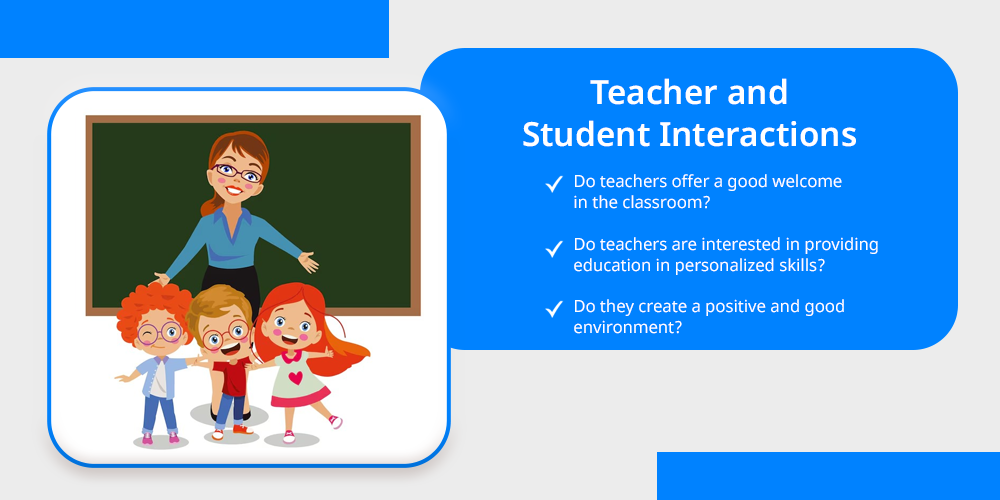
- Do teachers offer a good welcome in the classroom or discriminate against children?
- Do teachers are interested in providing education in personalized skills?
- Do teachers connect and communicate with students effectively?
- Do they create a positive and good environment?
3. Classroom Environment
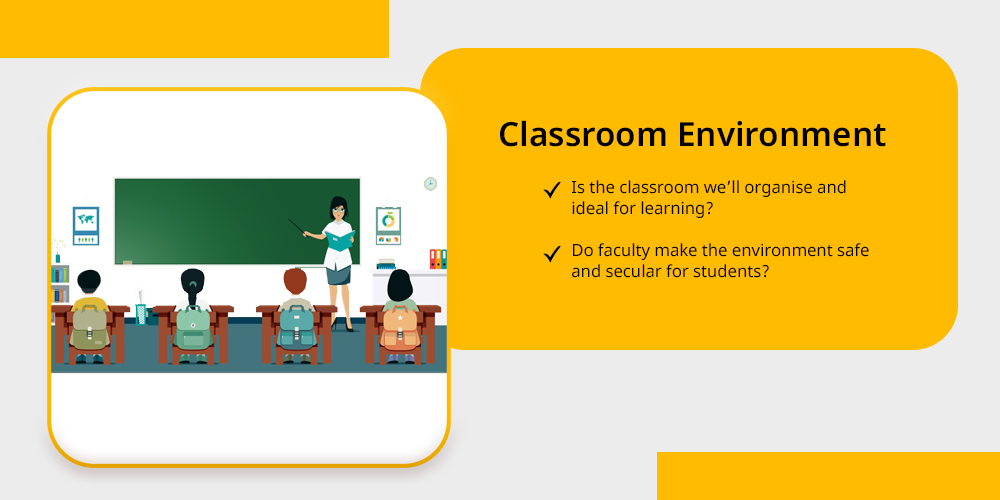
- Is the classroom we’ll organise and ideal for learning?
- Are all the materials for every kid?
- Do faculty make the environment safe and secular for students?
4. Instructional Strategies
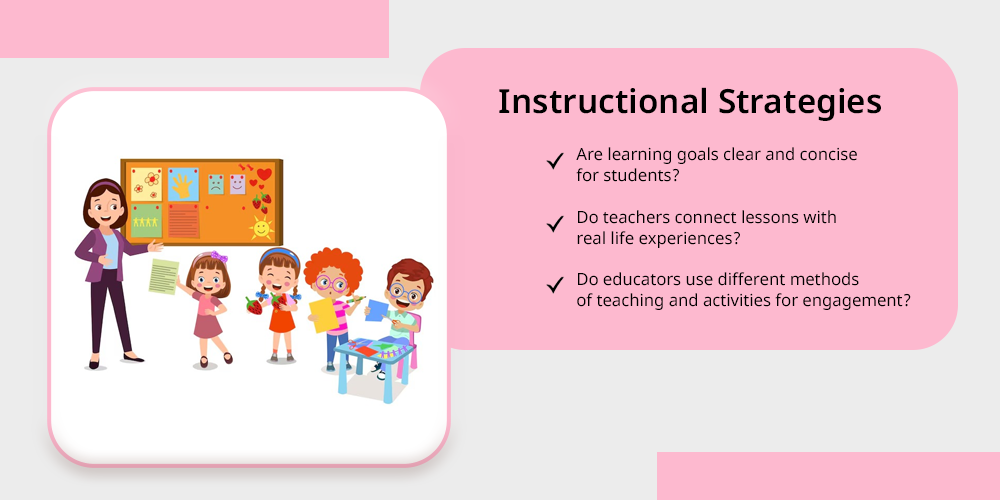
- Do educators use different methods of teaching and activities for engagement?
- Are learning goals clear and concise for students?
- Do teachers connect lessons with real life experiences?
5. Student-to-Student Interactions
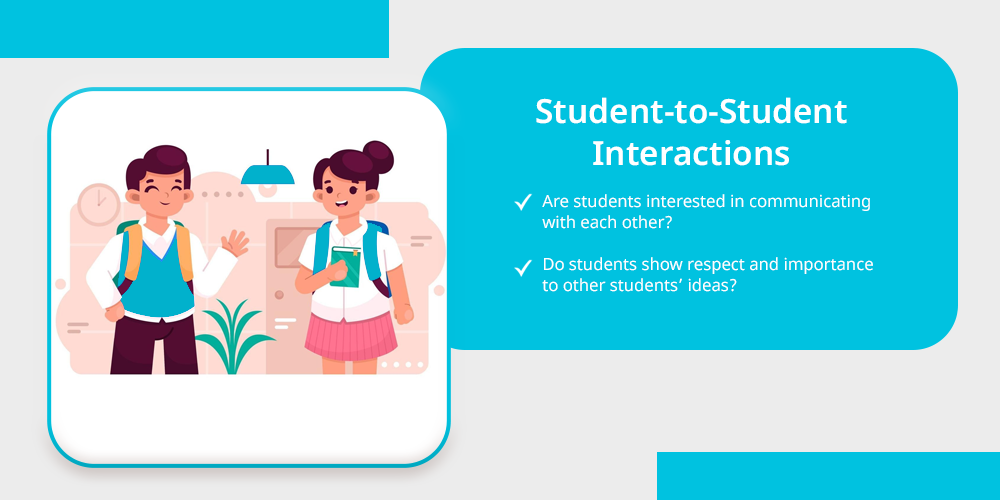
- Are students interested in communicating with each other?
- Do students to students interactions are positive?
- Do students show respect and importance to other students’ ideas?
6. Additional Observations

- Are students using technology in their learning?
- How do they generally behave in the classroom?
- How do students react to implementing new learning techniques?
This checklist helps teachers to observe students and guide them towards better objectives. Use an ideal checklist for an effective outcome.
Types of Student Engagement
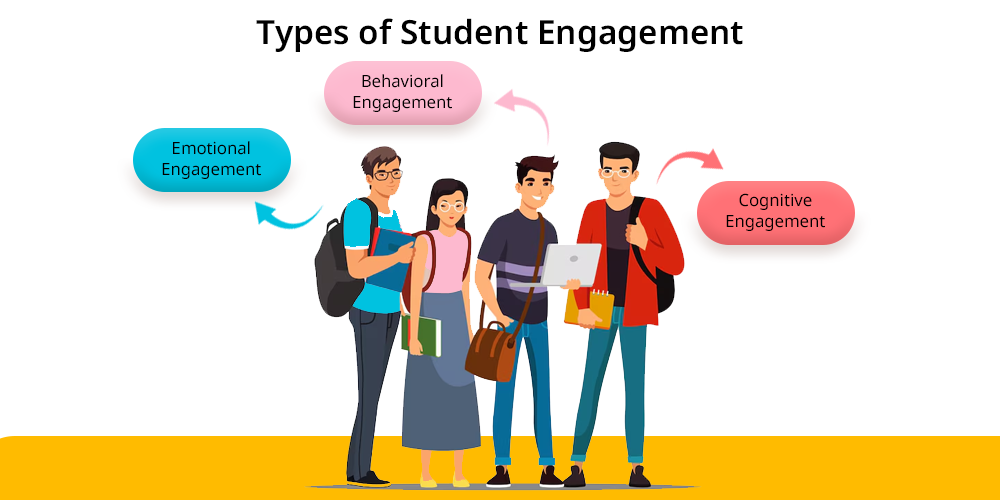
By understanding three main types of student engagement the experience of learning can be uplifted by the educator.
It’s time to address the gaps more precisely to achieve better student engagement. The three main types of engagement are:
- Emotional Engagement
Emotional engagement refers to how students feel about school, their teachers, peers, and the overall learning experience.
Any emotionally engaged students always connected with teachers and classmates in a good vibes.
- Behavioral Engagement
Behavioural engagement in students means the most visible participation and action in learning.
Visible participations such as attending class completing homework, science assignments, taking homework tips, participation in discussions.
It is a general demonstration of students whether they are engaged in a common work of school and classroom activities.
- Cognitive Engagement
Cognitive engagement is a mental effort and intellectual investment which students put into their daily learning.
In this type, students actively use their critical thinking skills to understand the problem and obtain a solution from the given information.
By seeking clarification on various maths or science problems and participating in group learning.
Benefits of Student Engagement
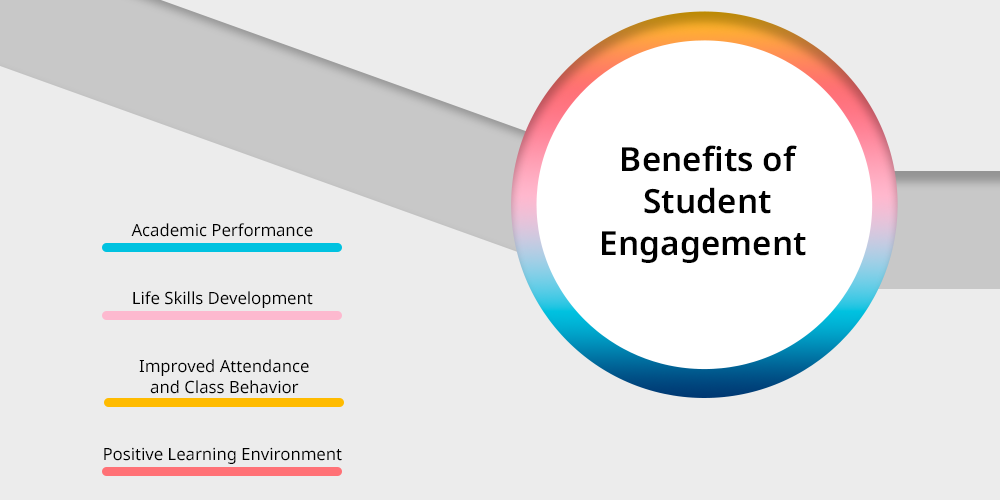
1. Academic Performance
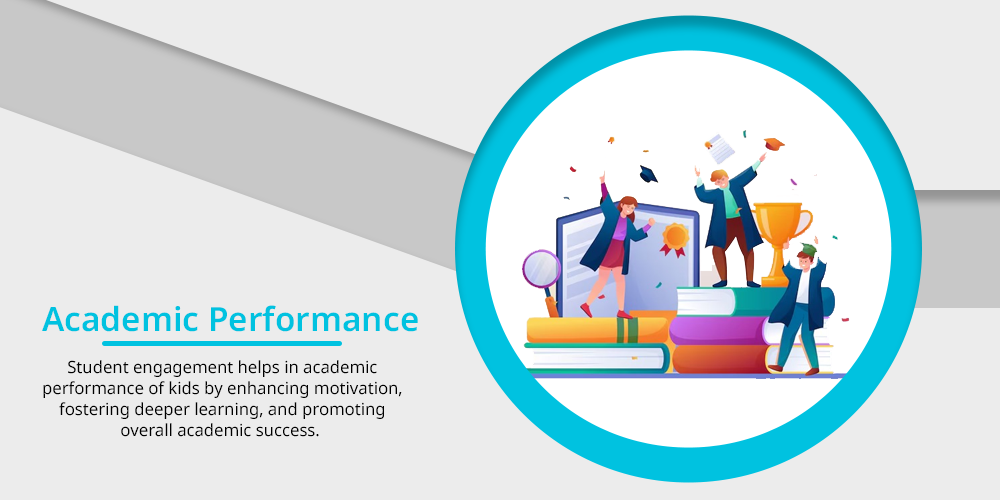
Student engagement helps in academic performance of kids by enhancing motivation, fostering deeper learning, and promoting overall academic success.
This not only improves academic performance but also helps in building a better environment for future growth and development.
2. Life Skills Development
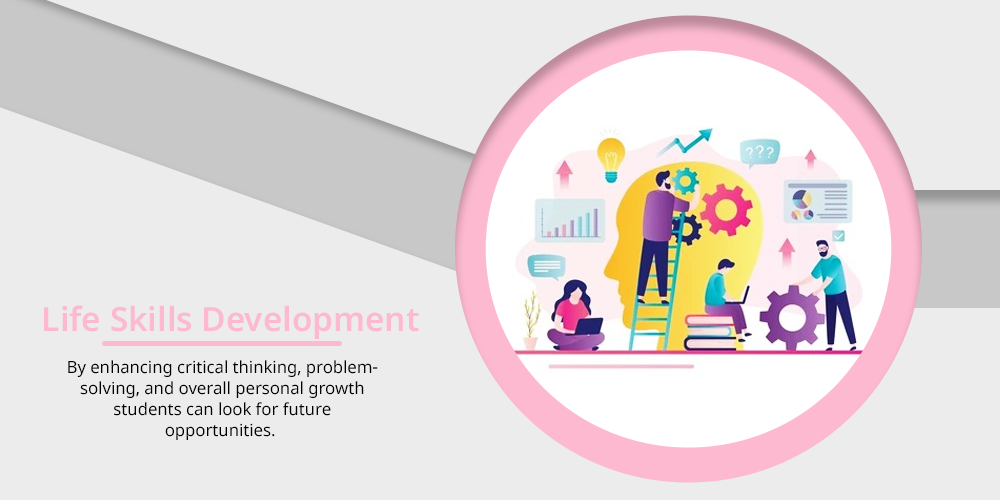
One of the direct benefits of student engagement is life skill development. By enhancing critical thinking, problem-solving, and overall personal growth students can look for future opportunities.
This will lead to productive learning, talent allocation and work as a multi talented.
3. Improved Attendance and Class Behavior
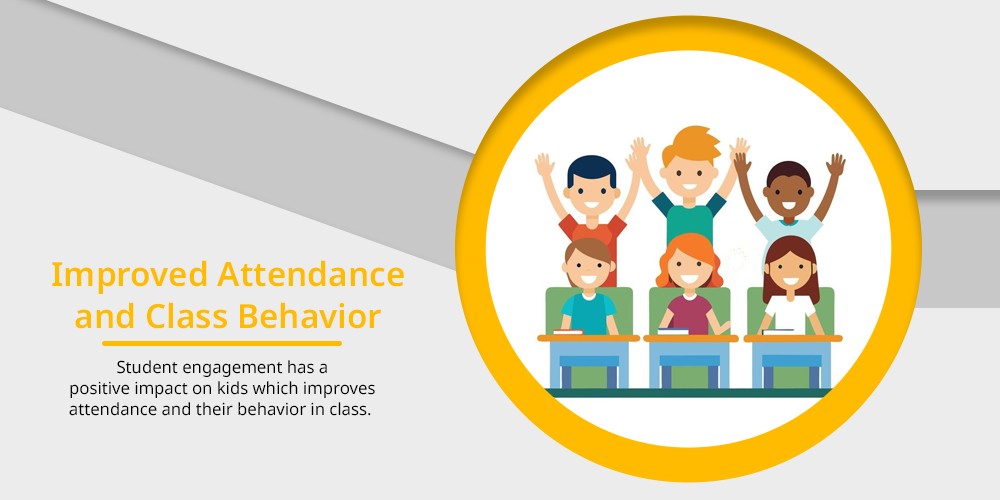
Student engagement has a positive impact on kids which improves attendance and their behavior in class.
This leads to lower absenteeism, fewer disciplinary issues, and stronger classroom dynamics.
4. Positive Learning Environment
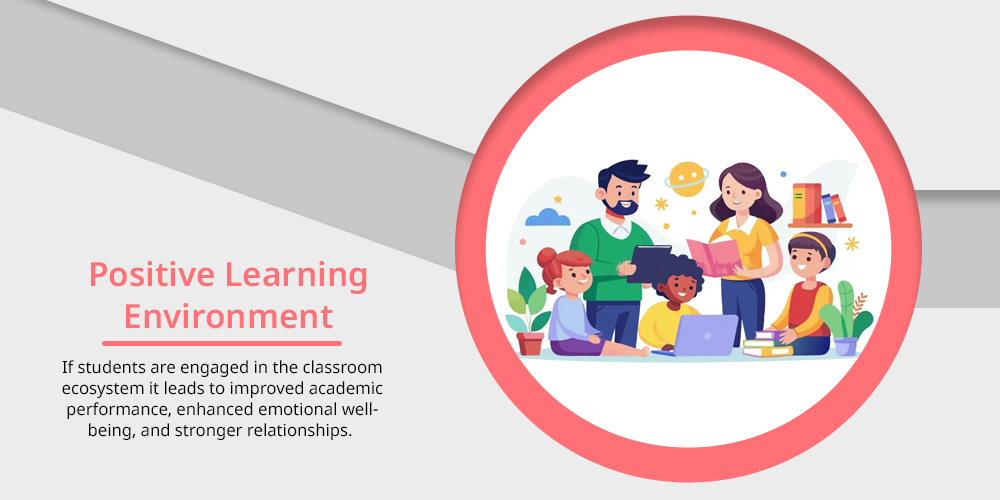
If students are engaged in the classroom ecosystem it leads to improved academic performance, enhanced emotional well-being, and stronger relationships.
It empowering students to succeed both academically and personally.
Factors Affecting Student Engagement
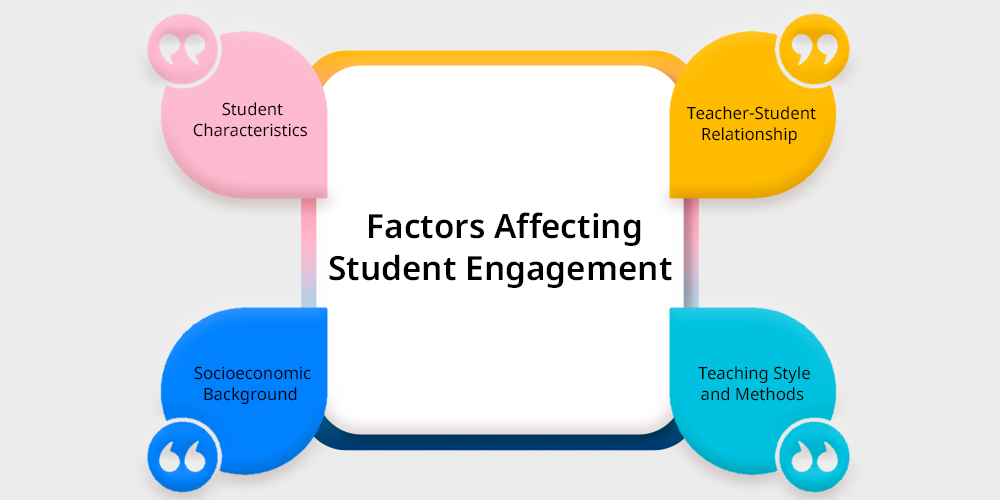
There are various factors that influence student engagement in class. Here’s some common points to note:
1. Student Characteristics
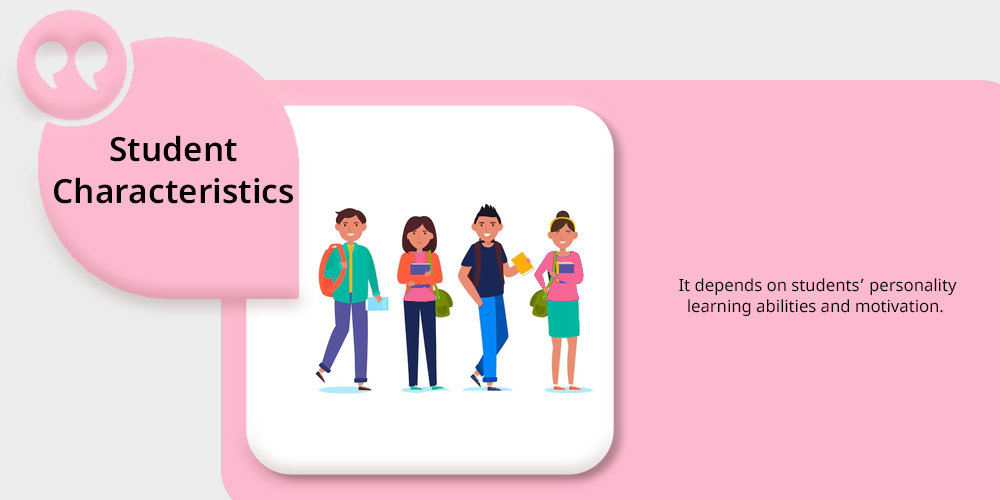
Student characters play a major role in their engagement in class. It depends on students’ personality, learning abilities and motivation.
This factor commonly categories into behavioral from emotional and cognitive dimensions, all of which impact a student’s level of participation in the learning process.
2. Teacher-Student Relationship
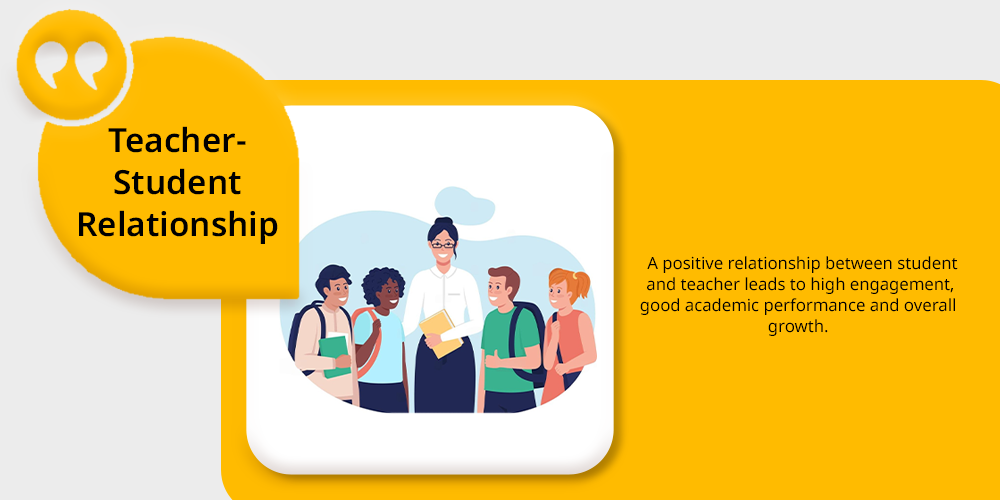
A positive relationship between student and teacher leads to high engagement, good academic performance and overall growth.
However, sometimes teacher-student relationship factors affect the engagement in the classroom.
3. Socioeconomic Background
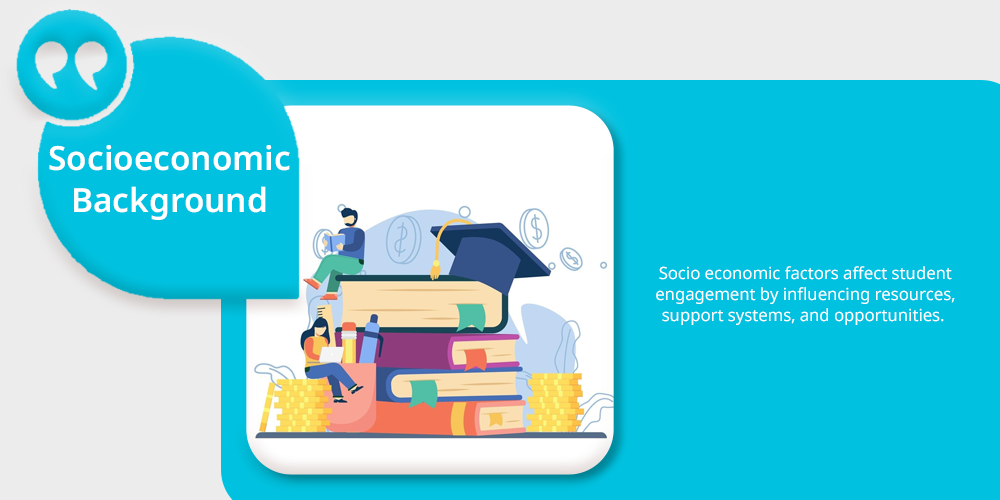
Socio economic factors affect student engagement by influencing resources, support systems, and opportunities. This will ultimately back the academic performance of students.
4. Teaching Style and Methods
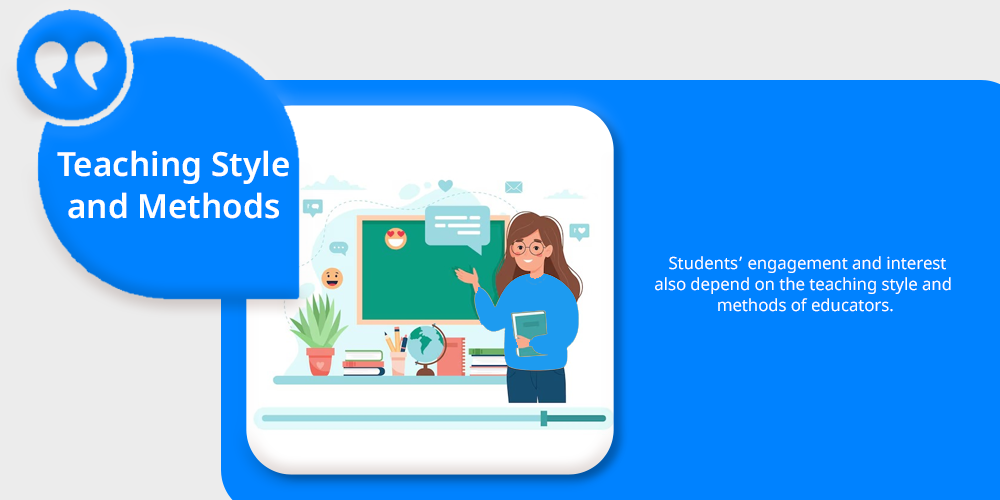
Students’ engagement and interest also depend on the teaching style and methods of educators. Differentiated learning can be helpful for students engagement.
Challenges in Promoting Student Engagement
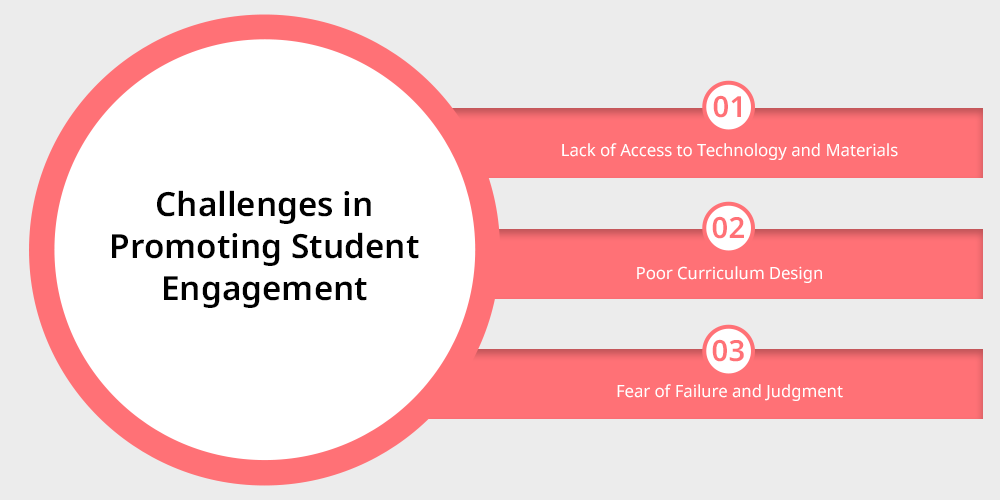
Some common challenges faced in promoting student engagement are:
1. Lack of Access to Technology and Materials
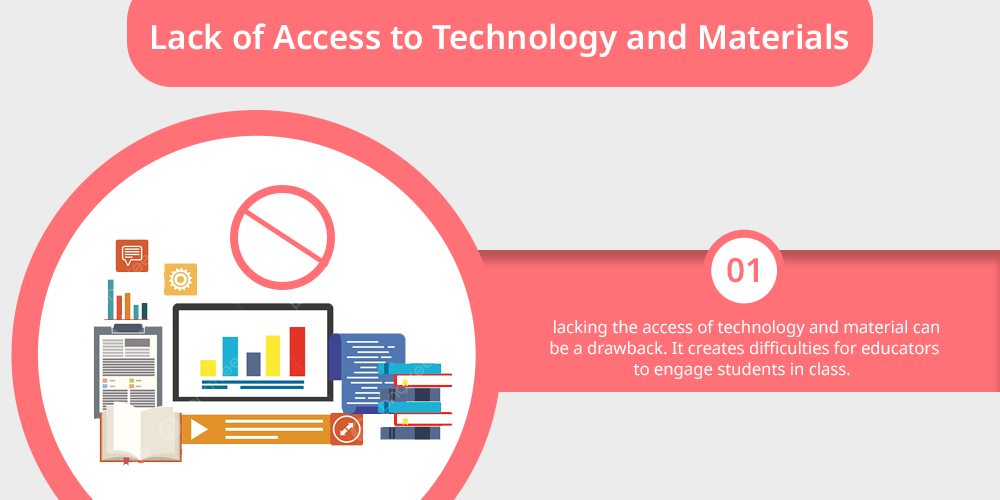
Technology and material is essential for student engagement. It provides a more inclusive learning environment.
However, lacking the access of technology and material can be a drawback. It creates difficulties for educators to engage students in class.
2. Poor Curriculum Design
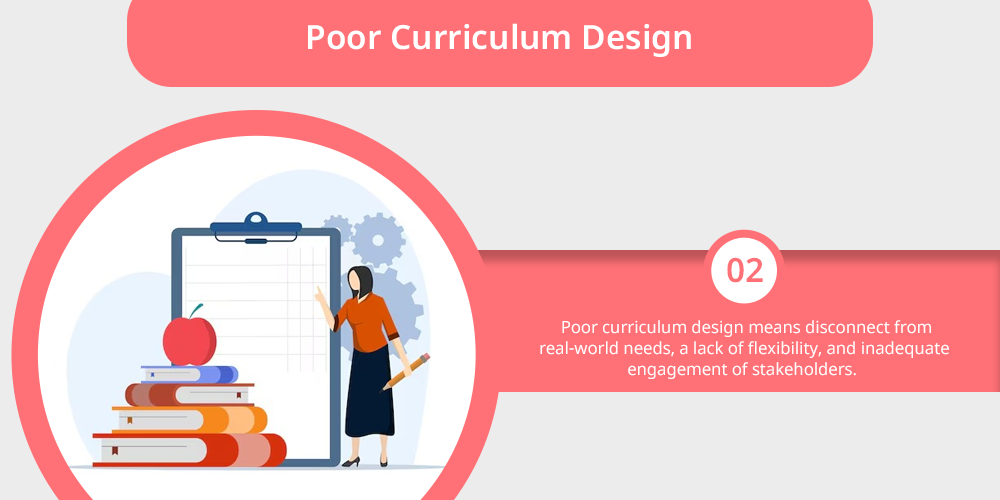
Poor curriculum design means disconnect from real-world needs, a lack of flexibility, and inadequate engagement of stakeholders.
This leads to disinterest and reduced learning results.
3. Fear of Failure and Judgment
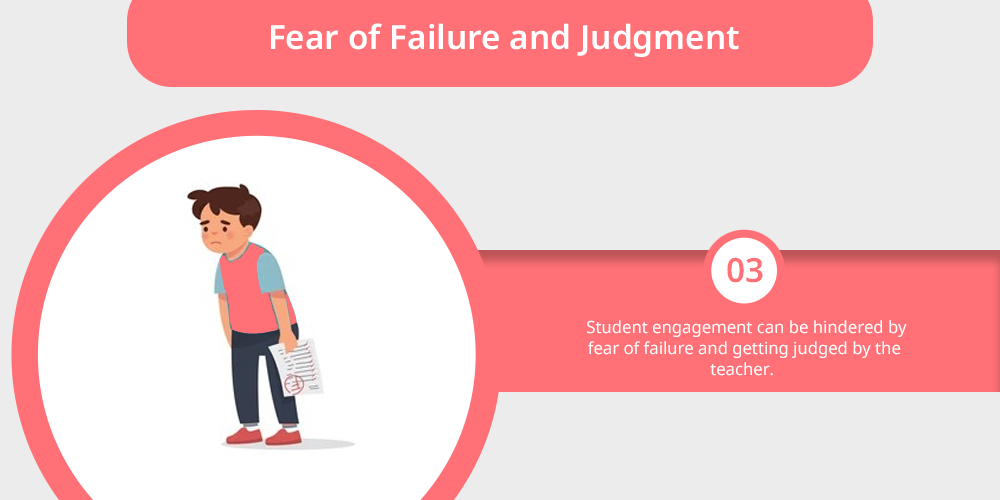
Student engagement can be hindered by fear of failure and getting judged by the teacher.
This can reduce participation, interest in learning, increase anxiety, and potentially lower academic performance. However, addressing the concern and finding a solution is crucial.
Effective Strategies or Best Practices for Student Engagement
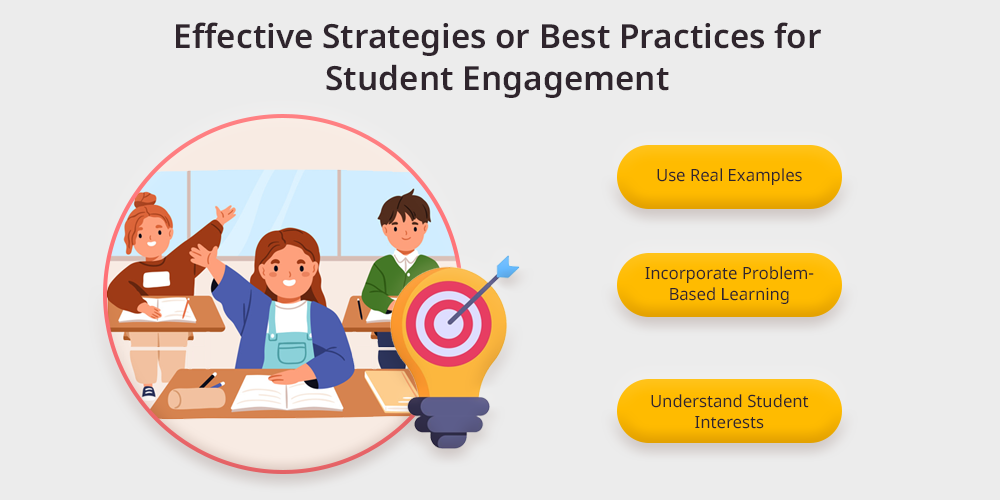
To overcome the factors influencing and challenges to promote student education educators need effective strategies.
With interactive activities, personalized learning, fosters collaboration and builds a supportive environment classroom becomes interactive. Some popular methods to help get your kids engaged in remote learning:
- Use Real Examples:
Teachers can use personalized learning, real-world applications and interactive activities like creative writing, math quizzes for student engagement in class.
This will connect students with real life situations and find solutions accordingly.
- Incorporate Problem-Based Learning:
PBL or problem based learning mainly focuses on authentic and relevant problems, fostering collaboration, encouraging self-directed learning, and providing clear learning outcomes and feedback.
- Understand Student Interests:
By understanding students’ interests, educators can make strategies to foster a positive learning environment in which students feel comfortable and valued.
Each student has different interests such as some like to try creative painting ideas or some love coding or programming languages.
If your kid loves to code and wants to learn new things in programming. You must read How to Engage Kids in Learning to Code.
How Online Education is Evolving to Meet New Engagement Needs?
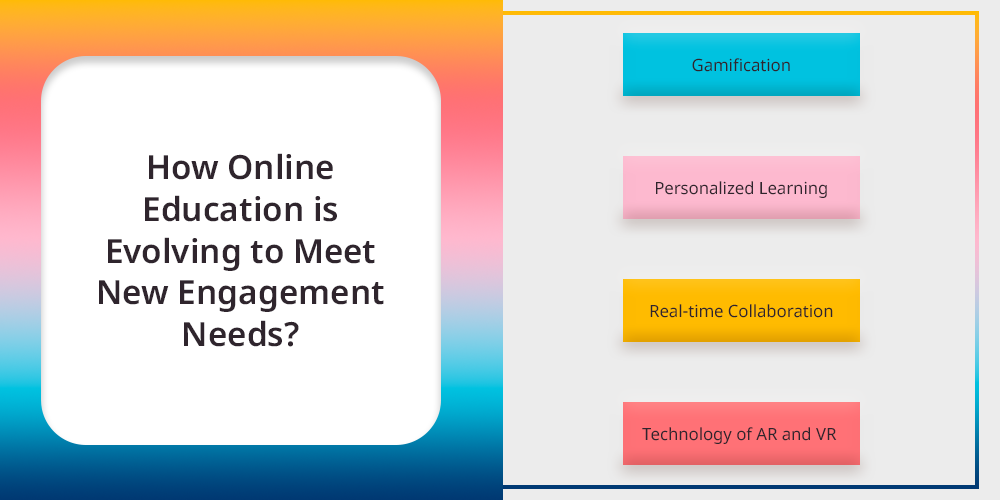
Today online learning has evolved and provides much more benefits than traditional schools. Popular schools like 21K school are ideal options to fulfill all requirements.
To know more about online education read advantages of online learning.
The future of online education is diverse and capable of meeting the needs of student engagement.
By integrating interactive elements, personalized learning experiences, and collaborative tools to enhance student engagement and motivation.
To learn effectively choose the right online learning platform among all. Here’s how online education platforms become ideal for interactive learning:
1. Gamification
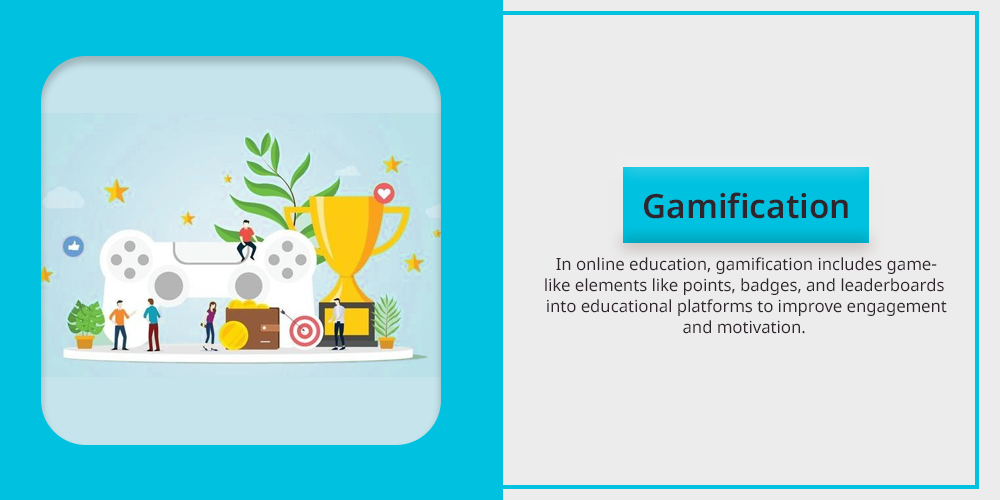
In online education, gamification includes game-like elements like points, badges, and leaderboards into educational platforms to improve engagement and motivation.
This boosts students’ interest and engagement which leads to good academic performance.
2. Personalized Learning
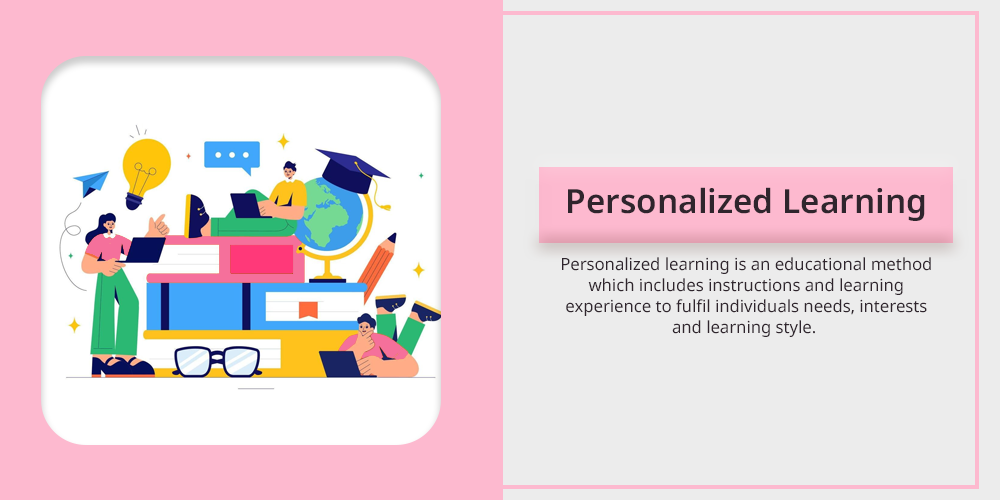
Personalized learning is an educational method which includes instructions and learning experience to fulfil individuals needs, interests and learning style.
AI-based tutorials and customized learning are some common examples. Educators ensure that students are engaged, motivated, and able to achieve their full potential.
3. Real-time Collaboration
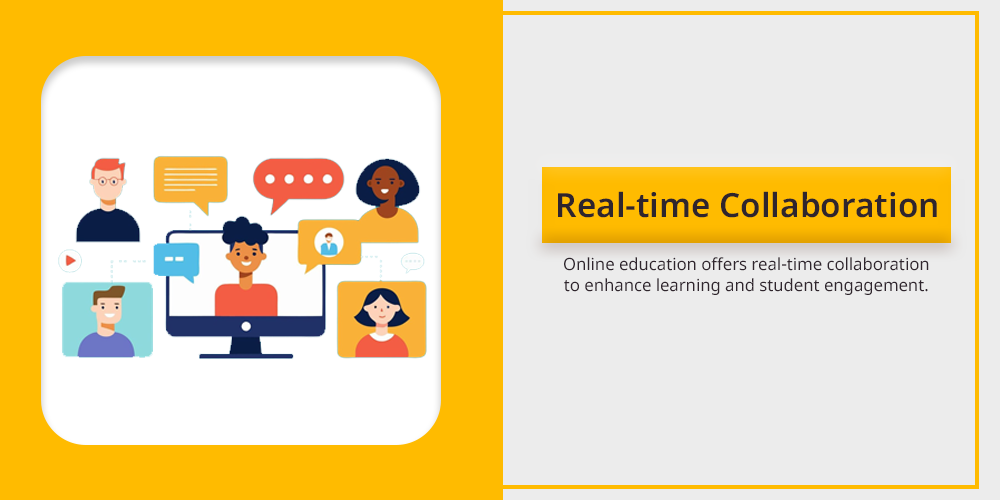
Online education offers real-time collaboration to enhance learning and student engagement. These collaboration tools include screen sharing, breakout rooms, and whiteboarding.
It’s time to create a more dynamic environment for students with online education.
4. Technology of AR and VR
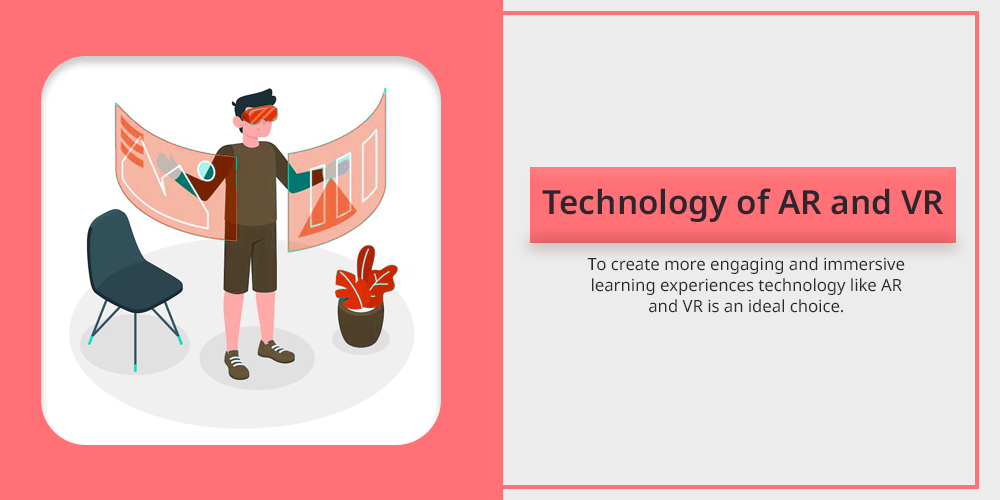
To create more engaging and immersive learning experiences technology like AR and VR is an ideal choice. This technological enhancement makes learning more enjoyable and effective.
10 Activities to Engage Students in Classroom
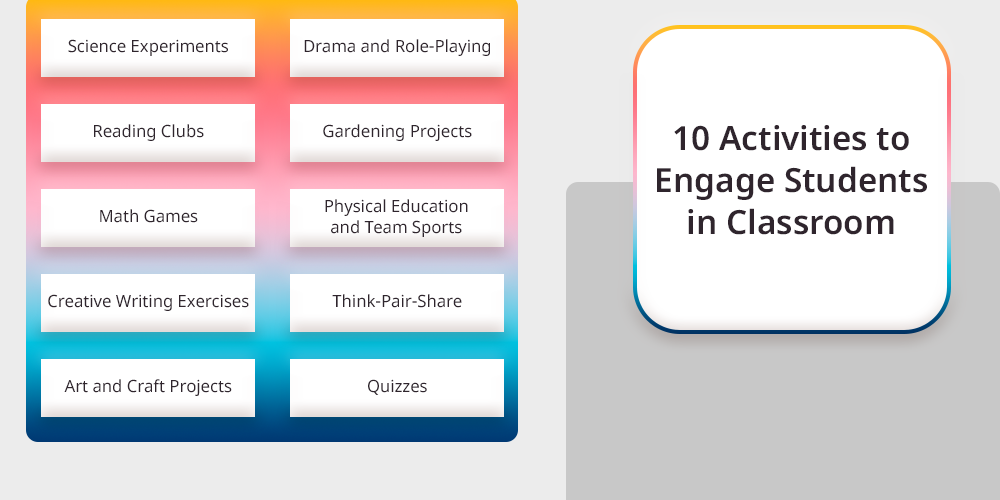
For effective learning, student engagement is a key to success. Let’s explore top 10 engaging activities that promote students engagement:
1. Science Experiments
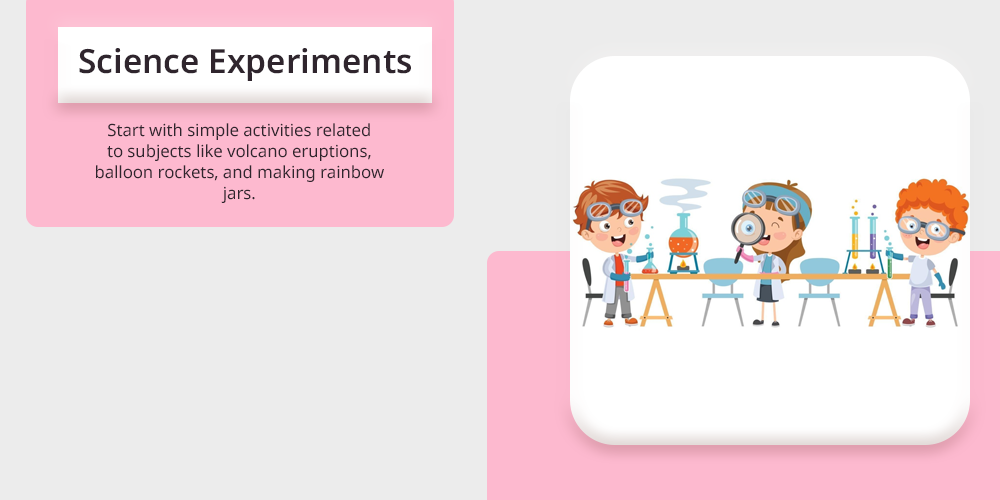
Engaging students in a science experiment is a fun and memorable way to learn new concepts. Choose age and course and appreciate experiments.
Start with simple activities related to subjects like volcano eruptions, balloon rockets, and making rainbow jars. These works generate curiosity and foster critical thinking.
- How to Do It: Make a small group within class and discuss the type of experiment. Plan in a simple way with safety. Observe and share the outcome of what is learned.
- Example: Use vinegar and baking soda for volcanic eruption. It is a fun chemistry reaction for kids.
- Tips for Success: Relate the experiment with the topic explained in class. Discuss the results before the experiment.
2. Reading Clubs
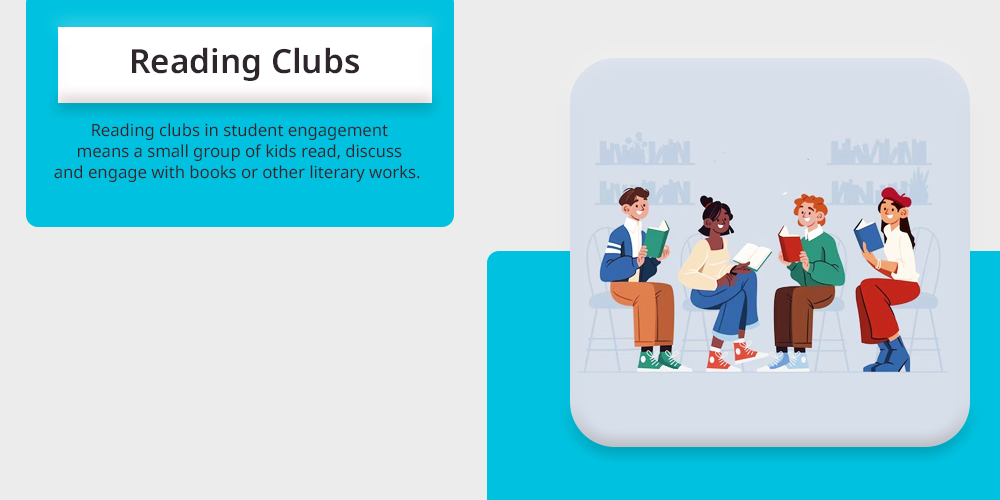
Reading clubs in student engagement means a small group of kids read, discuss and engage with books or other literary works.
Activities like book tasting, book character costumes, and creative writing prompts. With these activities students can engage themselves which improves comprehensive skills and reading habits.
- How to Do It: Make small groups and let them mutually decide the book. Schedule reading time and goal. Let them connect and conclude, discuss and give opinion on the story.
- Example: A group of students chooses the book name “Power of Habit” and discusses how to implement these habits in life.
- Tips for Success: Help students to choose the right book. Encourage them to make a good habit.
3. Math Games
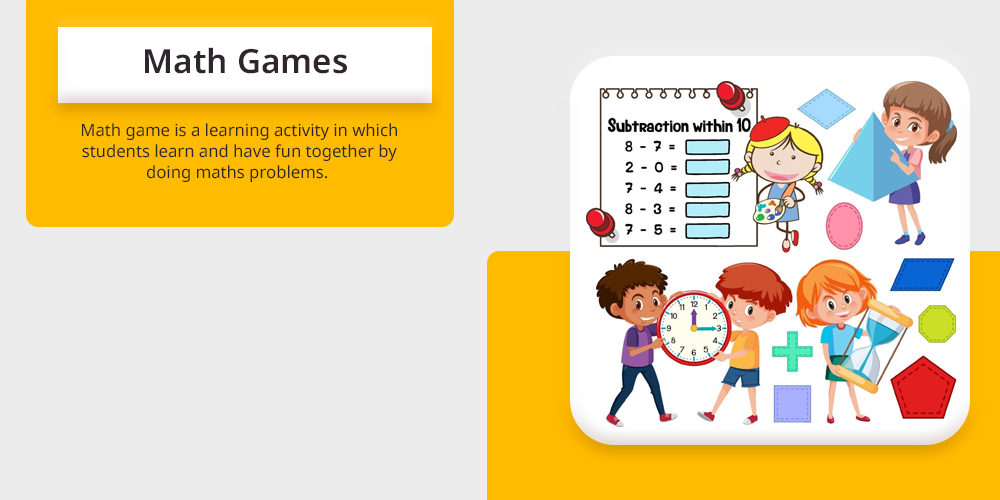
Math game is a learning activity in which students learn and have fun together by doing maths problems.
There are different types of games like 101 Points or math twister, based on age-appropriate teachers that can be introduced for student engagement.
- How to Do It: divide students into opposite teams and give math puzzles or questions to work together as a team. You can also track time or countdown to make it more fun and challenging.
- Example: students have maths bingo cards to play and the teacher calls the questions whoever completes the answers and aligns first wins.
- Tips for Success: cheer up the winner and participants.
4. Creative Writing Exercises
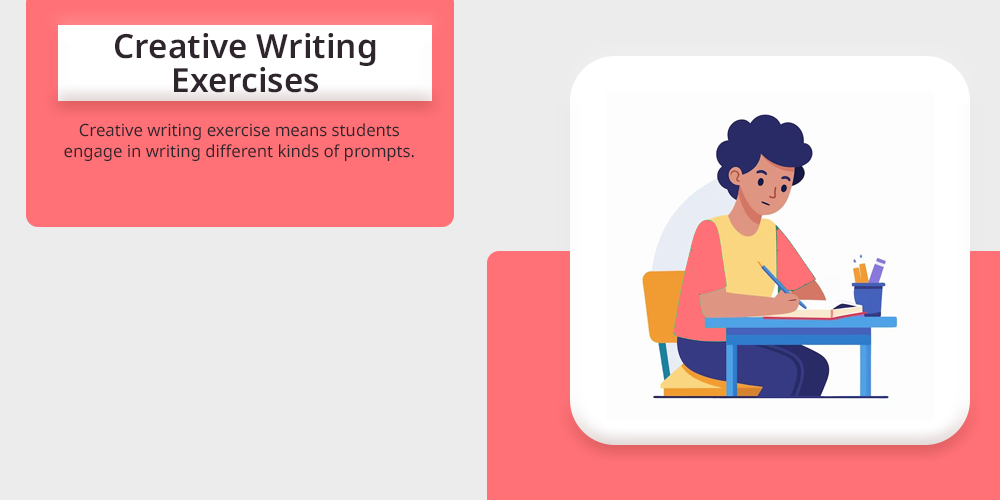
Creative writing exercise means students engage in writing different kinds of prompts. From poem, tagline to blocks on the favourite chapter or lesson.
Activities such as short stories, character diaries, dialogue writing.
- How to Do It: Give prompts to students based on their interest or make a small group and ask them to write a story and present it in a class.
- Example: Teacher gives a title for story writing like “Your Summer Holidays”.
- Tips for Success: Engage students with real time incidence to make their visual thinking better.
5. Art and Craft Projects
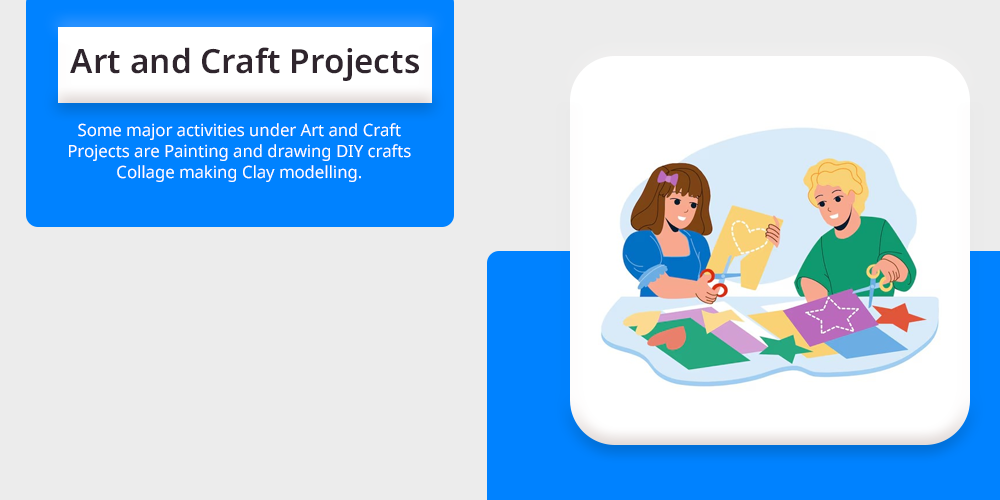
Art and craft activities are best for student engagement where teachers approach kids to create new things from colours, crayons and markers.
Some major activities under Art and Craft Projects are Painting and drawing DIY crafts Collage making Clay modelling. This will improve motor skills in kids.
Now one can learn online learning strategies to develop motor skills in students.
- How to Do It: Teachers help students with various activities like making animal masks and creative painting ideas for creative engagement.
- Example: Using science or arts diagrams to make creative drawings. Make a dream tree to write future goals.
- Tips for Success: Display students’ work in the classroom to make them happy by their creative activities.
6. Drama and Role-Playing
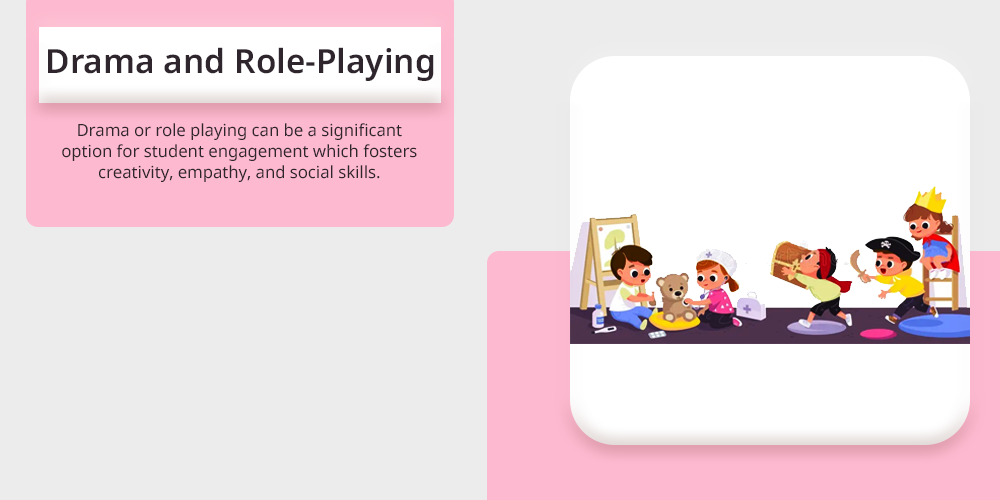
Drama or role playing means a kid or group of kids in class enacting a story which can be from an English subject or any book from the library.
Drama or role playing can be a significant option for student engagement which fosters creativity, empathy, and social skills.
- How to Do It: Teachers should assign the roles to students from the lesson. Choose English, or history to make it fun and engaging.
- Example: Reenact the story “The Proposal” from class 10th english book.
- Tips for Success: Use simple prompts or a part of the lesson to make it short and understandable.
7. Gardening Projects

Gardening project includes activities like planting vegetable gardens, growing herbs, and creating terrariums.
Engagement of students in some outdoor activities enhances their educational experience.
- How to Do It: Assign students small parts or areas and explain the steps to grow plants from seeds. Also monitor the environment, climate and how to grow them effectively.
- Example: Teachers help students in planting seeds and together they monitor seeds to grow and learn about plant kingdom.
- Tips for Success: Choose fast growing plants to make the activity simple and fast.
8. Physical Education and Team Sports
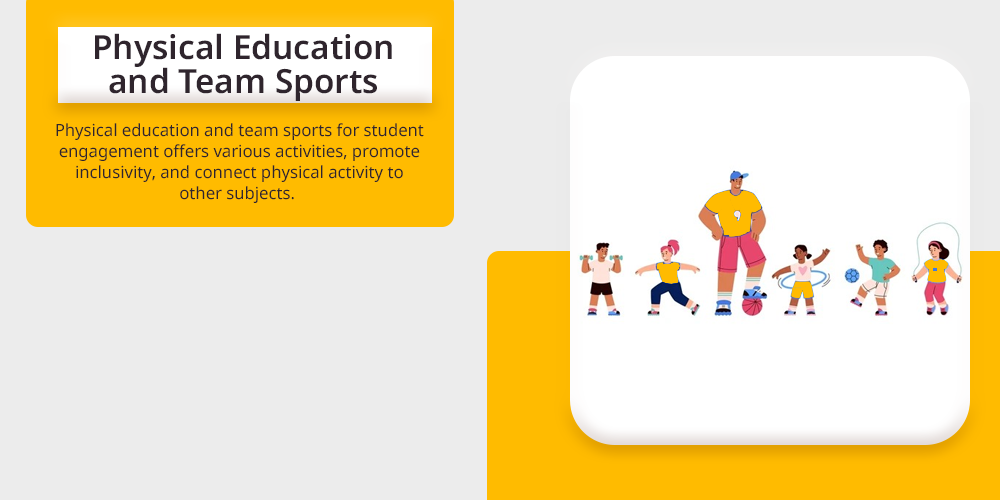
Physical education and team sports for student engagement offers various activities, promote inclusivity, and connect physical activity to other subjects.
This encourages participants to coordinate as a team of football, basketball or kabbadi. To improve gross motor skills students should go for sports.
- How to Do It: Organize a sports day which includes a lot of activities students can participate in.
- Example: Team solve the maths problem in every stage before moving forward.
- Tips for Success: Before starting do some warmup and focus.
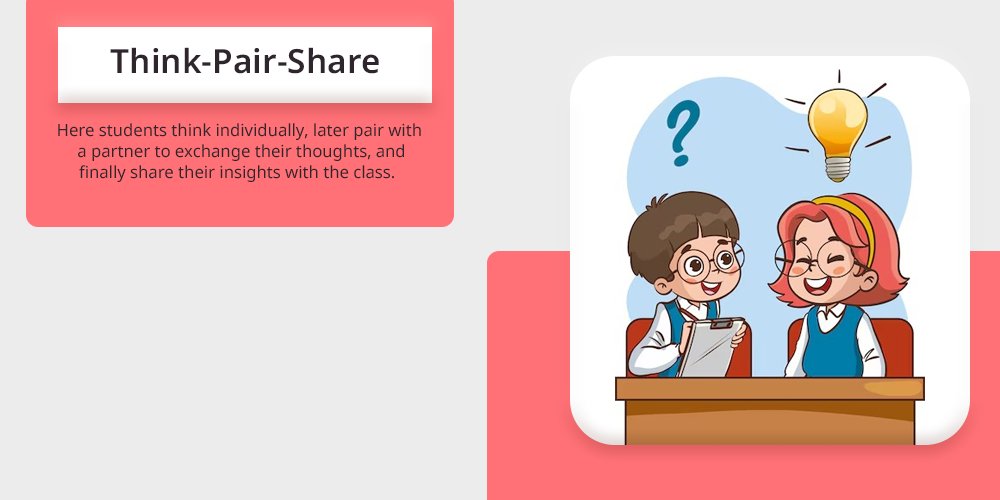
A popular classroom activity think-pair-share has three stages. Here students think individually, later pair with a partner to exchange their thoughts, and finally share their insights with the class.
The activity is ideal for kids’ engagement in class which leads to effective communication skills.
- How to Do It: Ask questions in the class and let students think about it. Later make a pair to resolve quickly and share the answer in the class.
- Example: What are the 10 good habits you have? Students think about themselves, discuss others and one by one answer.
- Tips for Success: Teachers can use open ended questions.
10. Quizzes
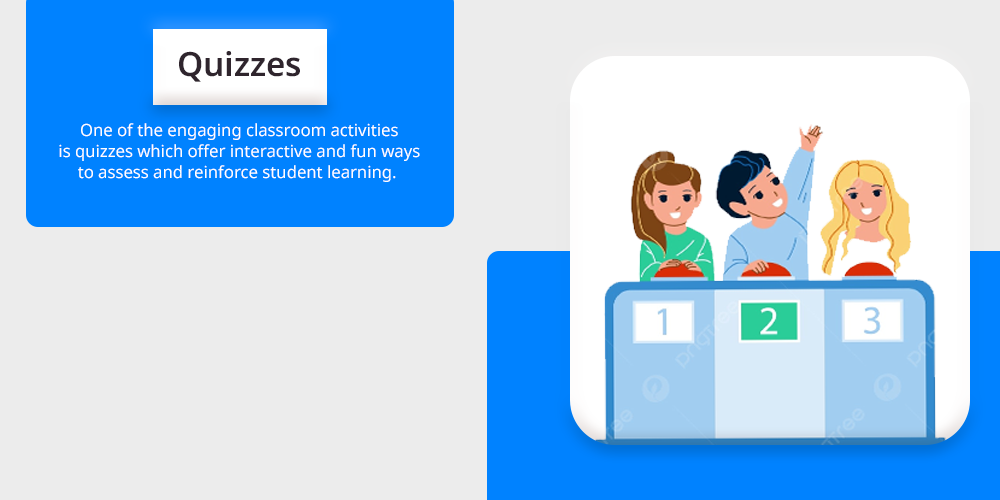
One of the engaging classroom activities is quizzes which offer interactive and fun ways to assess and reinforce student learning.
There are different types of quizzes from traditional to interactive pictionary based quizzes.
- How to Do It: Choose the right kind of quiz among all based on students age and class. Share the quiz and start a countdown.
- Example: Students draw pictures from the book and other students guess the character or image.
- Tips for Success: Keep it short and simple.
Examples of Student Engagement
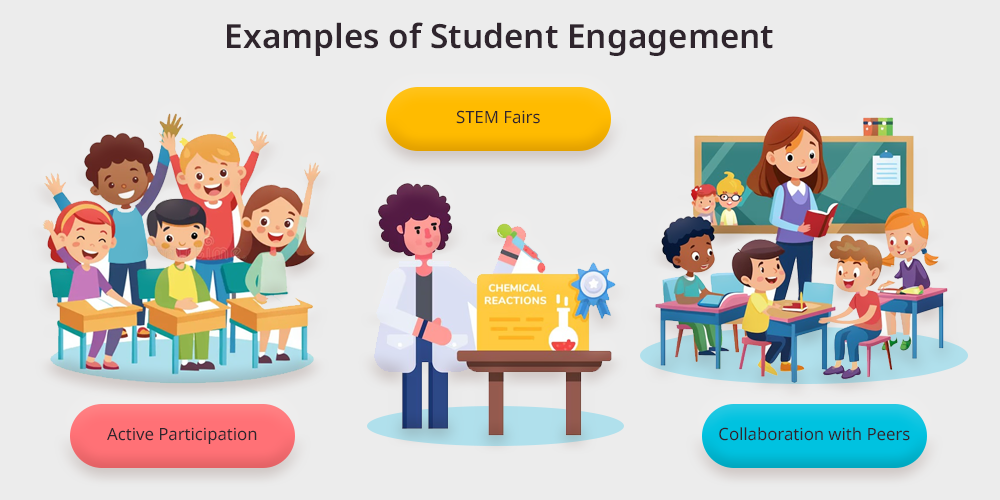
Some real world example that highlights the need of student engagement in class are:
- Active Participation: Student engagement reflects in the kids who actively participate in class work, ask questions and discuss with their classmates for better understanding.
- STEM Fairs: Science fair is an Idol for students who want to represent their project in the school. STEM knowledge helps students in both interaction and sharing information.
- Collaboration with Peers: Students who work with other classmates to resolve any query, puzzle or take participation in quizzes is an ideal example of collaboration and engagement.
Remember these are some common examples for student engagement in the classroom.
Key Takeaways!
Student engagement is a backbone of effective education. And teachers play an important role to engage students at each level.
Now with the evolving landscape of online education it becomes easy for teachers to engage students with the help of innovative strategies and thoughtful activities.
By focusing on factor influencing and challenges of student engagement teachers can transform classrooms into a vibrant place for learning.
It’s time to choose the right education instead of traditional approaches.


